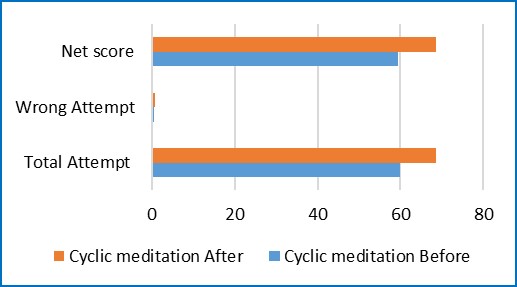Effect of Cyclic Meditation on selected Psychological Variables among Corporate Employees
DOI:
https://doi.org/10.21760/jaims.v6i3.1306Keywords:
Cognitive functions, cyclic meditation (CM), corporate employees, SLCT, DLST.Abstract
Background: Today’s competitive work environment has created enormous amount of stress on corporate employees, the impact of this as seen on impaired cognitive Functions and compromised mental health, there is a connection between cognition impairment with occupational stress. Mind-body techniques such as cyclic meditation (CM) have shown to improve cognitive functions, reduce stress and enhancing psychological wellbeing. The objective of this study was to determine whether cyclic meditation enhances the cognitive functions. Material and Methods: Thirty-five participants who had enrolled in a fifteen days cyclic meditation program. Their ages ranged between 20 and 60 years (group average ±S.D. 38.4±9.3 years, both genders). Those who have any chronic illness and mental illness, and those who are not willing to participate were excluded. Cyclic meditation is given for 15 days, 40 min./day. At baseline and following fifteen days, all participants completed DLST and SLCT. Results: cyclic meditation program showed significant change in DLST scores, increase (P-value< 0.001) in total attempted score, significant increase (P-value<0.001) in net score. Significant change in SLCT scores, significant increase (P-value<0.001) in total attempted score, similarly, significant increase (P-value<0.001) in net score, but there was no reduction in wrong attempt scores on both the tests (P-value >0.05). Conclusions: The fifteen days of cyclic meditation practice was successful in enhancing the cognitive function among corporate employees.
Downloads
References
K Landolt P, Maruff B, Horan et al. “Chronic work stress and decreased vagal tone impairs decision making and reaction time in jockeys,”. Psychoneuroendocrinology. 2017; 84: 151–158.
Girotti M, Adler SM, Bulin SE, Fucich EA, Paredes D, & Morilak DA. Prefrontal cortex executive processes affected by stress in health and disease. Progress in Neuro-Psychopharmacology and Biological Psychiatry. 2018; 85:161-179.
Kim S, Pyun K, Sim I. Stress and cognitive dysfunction. Korean J Stress Res. 2005;13:283–288.
Sarang SP, Telles S. Immediate effect of two yoga based relaxation techniques on performance in a letter-cancellation task. Percept Mot Skills. 2007; 105:379–85.
Subramanya P, Telles S. A review of the scientific studies on cyclic meditation. Int J Yoga, 2009; 2(2): 46–8. Available from: http://www.ncbi.nlm.nih.gov/pubmed/20842263
Natu MV, Agarawal AK. Testing of stimulant effects of coffee on the psychomotor performance: an exercise in clinical pharmacology. Indian Journal of Pharmacology. 1997; 29(1): 11–14.
Lezak MD. Neuropsychological Assessment 3rd Ed. New York. Oxford UP, 1997.
Van Hoof JJ, Jogems-Kosterman BJ, Sabbe BG, Zitman FG, & Hulstijn W. Differentiation of cognitive and motor slowing in the Digit Symbol Test (DST). Differences between depression and schizophrenia. J Psychiatr Res, 1998; 32: 99–103.
Vempati RP, Telles S. Baseline occupational stress levels and physiological responses to a two day stress management program. J Indian Psychol. 2000; 18: 33–7.
Sarang SP, Telles S. Immediate effect of two yoga based relaxation techniques on performance in a letter-cancellation task. Percept Mot Skills. 2007; 105: 379–85.















